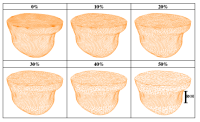Mesh simplification based on edge collapsing could improve computational efficiency in near infrared optical tomographic imaging.
Dilip Mathew Thomas, Phaneendra K. Yalavarthy, Deepak Karkala, and Vijay Natarajan.IEEE Journal of Selected Topics in Quantum Electronics (issue on biophotonics), 18(4), 2012, 1493-1501.
Abstract
The diffusion equation based modeling of near infrared light propagation in tissue is achieved by using finite element mesh for imaging real-tissue types, such as breast and brain. The finite element mesh size (number of nodes) dictates the parameter space in the optical tomographic imaging. Most commonly used finite element meshing algorithms does not provide the flexibility of distinct nodal spacing in different regions of imaging domain to take the sensitivity of the problem into consideration. This work aims to present a computationally efficient mesh simplification method that can be used as a preprocessing step to iterative image reconstruction, where the finite element mesh is simplified by using an edge collapsing algorithm to reduce the parameter space at regions where the sensitivity of the problem is relatively low. It is shown, using simulations and experimental phantom data for simple meshes/domains, that a significant reduction in parameter space could be achieved without compromising on the reconstructed image quality. The maximum errors observed by using the simplified meshes were less than 0.27% in the forward problem and 5% for inverse problem.[PDF]
